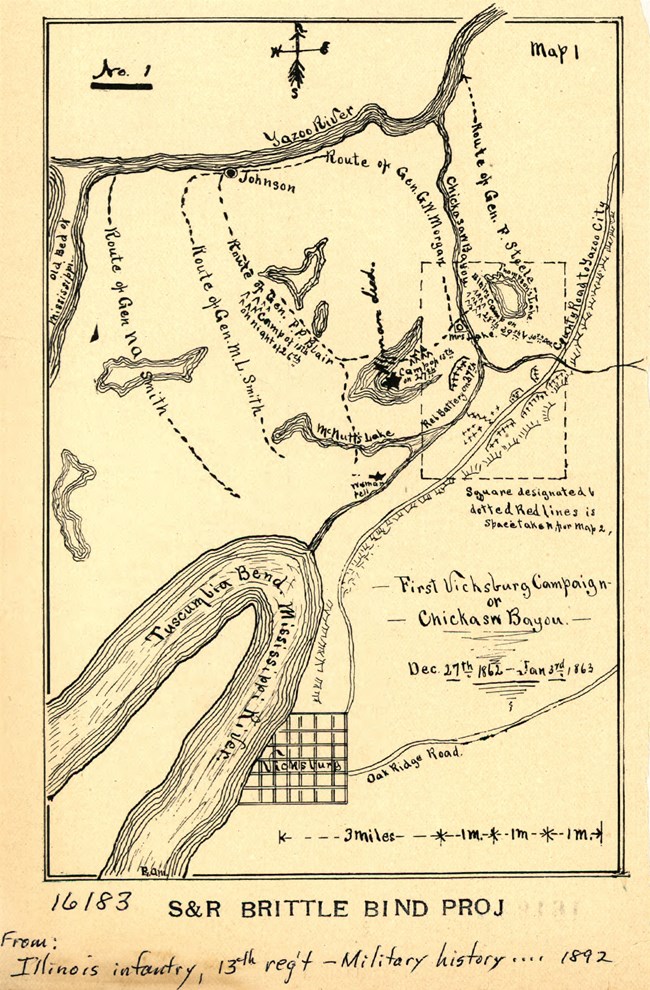Last updated: August 4, 2023
Article
The Long View: Preserving Chickasaw Bayou Battlefield

Image courtesy of the Library of Congress, Geography and Map Division.
Recipient: Mississippi Department of Archives and History
Amount: $424,157.50
Acres: 8.56
Project Update: In July, 2023, another NPS ABPP Battlefield Land Acquisition Grant preserved an additional 1.5 acres of Chickasaw Bayou Battlefield, through the efforts of the Mississippi Department of Archives and History and the American Battlefield Trust.
July 3, 1863, a turning point in the Civil War: Lt. Gen. John Pembroke, commander of besieged Confederate forces at Vicksburg, Mississippi, sued for peace while Union forces were delivering a bloody defeat to Gen. Robert E. Lee’s Army of Northern Virginia more than a thousand miles away. The road to Maj. Gen. Ulysses S. Grant’s victory in the Vicksburg campaign—yielding control of the Mississippi River to the Union—reached back to Chickasaw Bayou.
In late 1862, Grant split the Union’s Army of the Tennessee into two wings in a bid to control Vicksburg and the river. While Grant’s forces advanced towards the city along the Mississippi Central Railroad, Maj. Gen. William T. Sherman led his troops south along the river. On December 26, Sherman encountered Pembroke’s forces two miles from Vicksburg at Chickasaw Bayou, a wide, chest-deep stream choked with trees that provided natural cover to the Confederate forces. After three days of unsuccessful attacks on Confederate defenses stationed on the bayou’s Walnut Hills, Sherman shifted the Union’s offensive to the northeast, where high bluffs could offer cover for the Federal assault. By January 2, with Grant’s overland expedition failing and communication and supply lines damaged, Sherman withdrew to the mouth of the Yazoo River. "I reached Vicksburg at the time appointed, landed, assaulted, and failed," he explained. Vicksburg would continue to remain a Confederate stronghold, but by April 1863, the siege was on.
With financial assistance from the NPS American Battlefield Protection Program’s Battlefield Land Acquisition Grant program, the Mississippi Department of Archives and History and the American Battlefield Trust continue their collaborative conservation efforts at Chickasaw Bayou Battlefield. Building on an initial acquisition in late 2022, the partners will acquire three more properties, totaling just over 7 acres of the Chickasaw Bayou battlefield landscape. This grant, which protects woodlands occupying half the property, conserves open space and the natural resources that, in the long run, contribute to our collective well-being and the health of the planet.
Battlefield Land Acquisition Grants from the NPS American Battlefield Protection Program empower preservation partners nationwide to acquire and preserve threatened Revolutionary War, War of 1812, and Civil War battlefields. In addition, the program administers three other grants: Preservation Planning Grants, which are open to all sites of armed conflict on American soil, and Battlefield Restoration and Battlefield Interpretation Grant programs. This financial assistance sustains community-driven stewardship of historic resources at the state, tribal and local levels.
Get Your Project Funded
Check out the American Battlefield Protection Program's website for more information about various grant offerings and eligibility.
